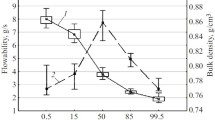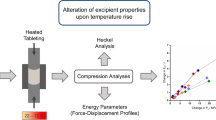Abstract
Defined size fractions of polyethyleneglycol powder (MW = 10,000) were mixed with defined size fractions of α-lactose monohydrate in order to study the effect of compaction as a function of the weight ratios of the two excipients. For a precise control of the compression cycle, tablets were compressed on a Universal Testing Machine (Zwick 1478). Tablet tensile strength σT was quantified as a function of compressional stress σc and relative density ρr using a two-parameter model with σTmax = maximal tensile strength at zero porosity and γ = compressibility. The results have been analyzed on the basis of the percolation theory. As soon as the component with the lower mechanical stability is percolating the powder system, tablet hardness is controlled entirely by this component. The percolation threshold is a function of the geometrical arrangement of the particles in the compressed powder system. The expected two percolation thresholds can be distinguished as a function of the composition weight ratios if the particle size distributions of the two components differ enough.
Similar content being viewed by others
REFERENCES
D. Stauffer. Introduction to Percolation Theory, Taylor & Francis, London and Philadelphia, 1985.
W. O. Smith, P. D. Foote, and P. F. Busang, Phys. Rev. 34:1272 (1929).
G. Bockstiegel and J. Hewing. Arch. Eisenhüttenwes. 36:1–17 (1965).
K.-H. Lüdde and K. Kawakita. Pharmazie 21:393–403 (1966).
T. R. R. Kurup and N. Pilpel. Powder Technol. 19:147–155 (1978).
A. Burger, R. Ramberger, and W. Schmidt. Pharmazie 36:41–46 (1981).
E. N. Hiestand and D. P. Smith. Powder Technol. 38:145–159 (1984).
H. Leuenberger and W. Jetzer. Powder Technol. 37:209–218 (1984).
H. Leuenberger. Int. J. Pharm. 12:41–47 (1982).
H. Leuenberger, E. N. Hiestand, and H. Sucker. Chem. Ing. Tech. 53:45 (1981).
H. Leuenberger and B. D. Rohera. Pharm. Res. 3:12–22 (1986).
H. Leuenberger. Proc. Pharm. Tech. Conf. 86, Hyatt, Cherry Hill, N.J., Sept. 16–18 (1986), pp. 180–195.
H. Leuenberger, B. D. Rohera, and Ch. Haas. Int. J. Pharm. 38:109–115 (1987).
W. Jetzer. Verpressbarkeit und Kompressibilität von pharmazeutischen Wirk-und Hilfsstoffen unter Berücksichtigung binärer Mischungen, Dissertation, Basel, 1982.
B. Galli. Ueber die Härte pharmazeutischer Presslinge und deren Voraussage am Beispiel von ternär-und mehrkomponenten Systemen, Dissertation, Basel, 1985.
B. D. Rohera. Compression Kinetic Study of Pharmaceutical Powder Systems, Thesis, Basel, 1984.
D. Blattner. Untersuchungen über das Komprimierverhalten binärer pulverförmiger Haufwerke, Dissertation, Basel, 1987.
J. T. Fell and J. M. Newton. J. Pharm. Pharmacol. 22:247–248 (1970).
M. Sheikh-Salem and J. T. Fell. Int. J. Pharm. Technol. Prod. Manuf. 2:19 (1981).
P. York and N. Pilpel. J. Pharm. Pharmacol. 25 (Suppl):1P–11P (1973).
R. W. Heckel. Trans. AIME 221:1001–1008 (1961).
A. R. Cooper and L. E. Eaton. J. Am. Ceram. Soc. 45:97–101 (1972).
P. C. Schmidt. Acta Pharm. Technol. 30 (4):302–311 (1984).
H. Vromans, A. H. de Boer, G. K. Bolhuis, and C. F. Lerk. Acta Pharm. Suec. 22:163–172 (1985).
H. Vromans, A. H. de Boer, G. K. Bolhuis, C. F. Lerk, K. D. Kussendrager, and H. Bosch. Pharm. Weekbl. Sci. 7:186–193 (1985).
A. H. de Boer, H. Vromans, C. F. Lerk, G. K. Bolhuis, K. D. Kussendrager, and H. Bosch. Pharm. Weekbl. Sci. 8:145–150 (1986).
H. V. van Kamp, G. K. Bolhuis, K. D. Kussendrager, and C. F. Lerk. Int. J. Pharm. 28:229–238 (1986).
A. A. Al-Angari, J. W. Kennerley, and J. M. Newton. J. Pharm. Pharmacol. 37:151–153 (1985).
J. T. Fell and J. M. Newton. J. Pharm. Sci. 60:1866–1869 (1971).
C. Führer. Acta Pharm. Technol. 12:143–153 (1966).
Author information
Authors and Affiliations
Rights and permissions
About this article
Cite this article
Blattner, D., Kolb, M. & Leuenberger, H. Percolation Theory and Compactibility of Binary Powder Systems. Pharm Res 7, 113–117 (1990). https://doi.org/10.1023/A:1015864415693
Issue Date:
DOI: https://doi.org/10.1023/A:1015864415693




